Some vintage Legos® test positive for high level of a known carcinogen. Can I tell if my Legos® are safe?
One of these small yellow Lego® bricks (pictured above) is vintage (the one on the left of the photo was purchased new, “between 1978 and 1988”) and tested positive for a very high level of Cadmium (a known carcinogen); the other is newer (belongs to my kiddos and was purchased sometime in the past 15 years) and is consistent with all my previous testing of non-vintage Lego® bricks — negative for all of the top metallic toxicants of Lead, Mercury, Cadmium, and Arsenic (which were, unfortunately, all too often used in the manufacturing of vintage plastic toys).
How can you tell the difference (between vintage and newer Legos®) – and protect your kiddos from potential Cadmium exposure? Here’s a guide.
For those new to this website:
Tamara Rubin is a multiple-federal-award-winning independent advocate for childhood Lead poisoning prevention and consumer goods safety, and a documentary filmmaker. She is also a mother of Lead-poisoned children (two of her sons were acutely Lead-poisoned in 2005). Since 2009, Tamara has been using XRF technology (a scientific method used by the U.S. Consumer Product Safety Commission) to test consumer goods for toxicants (specifically heavy metals — including Lead, Cadmium, Mercury, Antimony, and Arsenic). Tamara’s work was featured in Consumer Reports Magazine in February of 2023 (March 2023 print edition).
With this article, I am covering at least a few important sets of details that appear to not have been covered in any other articles online about the subject of Cadmium found in vintage Legos. This includes:
- How to potentially distinguish Cadmium-positive Legos® from Cadmium-free Legos®
- A report of the exact Cadmium readings (as detectable with an XRF) that we found in vintage Legos®
- How Cadmium levels found in these vintage Legos® compare to current/modern regulatory standards for other toys.
While this article is long, and the attention span of many of us reading articles online (especially those of us who are parents of young children) is short, I encourage you to take the time and read this full article as it contains a lot of information I expect you will find useful (plus, I took the time away from my kiddos to write it! ;-). Thank you.
First I want to discuss the concern for Cadmium found in toys (and the levels that are considered unsafe).
There is a bit of irony to be found in the fact that there are only two government entities in the world with the strictest protective standards for regulating the presence of Cadmium in consumer goods: Washington State (in the U.S.) and the country of Denmark. This is ironic because Denmark is where the universally popular iconic Lego® bricks originated, and is still home to their beloved original manufacturer!
What are the regulatory standards for the presence of Cadmium in consumer goods?
Washington State considers a newly manufactured (2019) item unsafe (and therefore illegal) with a total Cadmium content of 40 ppm or higher.
The country of Denmark considers any consumer good to be unsafe (by modern/current standards) if the item contains more than 75 ppm Cadmium.
Both of these regulatory standards are distinct from many other regulatory standards for toxicants, in that they are based on “total content” and NOT based on how much of the toxicant might be “leachable” — or, said another way, how much of the toxicant might migrate to the user (“when the product is normally used as intended”).
(The concern for the leaching of Cadmium is discussed in greater detail below.)
The Cadmium level I found in the vintage (1978-1988) Lego® yellow 2×4 building block pictured here came in at OVER 5,400 parts per million (ppm) as detectable with an XRF (with replicable 3-minute tests using a Niton XL3t XRF instrument specifically designed to test for and detect metal toxicants in consumer goods, such as Lead and Cadmium).
5,400 ppm far exceeds the regulatory standards of both Washington State and Denmark. Based on that fact alone, these vintage yellow Legos® should be considered unsafe for use by children.
This high level of Cadmium was also found in the vintage red Legos® I have tested (from the same era), and I will be publishing more examples of each of the different colored vintage Legos® and their specific respective XRF readings shortly (as well as linking each of those articles here when they are live).
Does The Lego Group know about this issue?
My findings of Cadmium in vintage Legos® are not new information.
Apparently, The Lego® Group (TLG) has been aware of this concern for at least three decades (hence the switch to Cadmium free plastic colorants sometime in the mid-to-late 1980s). More recently, the issue has also been well-studied by scientists.
Despite scientific consensus along with corporate awareness of the concern, as I understand it there has never been a product recall initiated as a result of this issue.
Here are some fairly recent relevant links, however, in my research for this article I also found online blog posts and write-ups about this concern dating as far back as 2005:
- Here’s a post from 2017: https://bricks.stackexchange.com/questions/8543/was-there-ever-cadmium-in-lego-bricks
- Here’s an article from January 2018: https://www.bbc.com/news/health-42832978
- Here’s an article from February 2018: https://offspring.lifehacker.com/your-old-legos-might-be-toxic-1822608757
- The articles above reference Dr. Andrew Turner’s study from 2018: https://pubs.acs.org/doi/abs/10.1021/acs.est.7b04685?journalCode=esthag
Based on the abstract of Dr. Turner’s study (linked above), it does appear that leaching of Cadmium from vintage Lego® bricks can happen and at levels that are quite concerning.
However, it also appears The Lego® Group (TLG) may have previously asserted that leaching of Cadmium is not a concern, (this is noted based on the comments from the Lego® historian quoted in the first link above — quote seen below).
From Dr. Turner’s study’s abstract:
In eight cases, Cd or Pb exceeded their migration limits as stipulated by the current EU Toy Safety Directive (17 and 23 μg g–1, respectively), with Cd released from yellow and red Lego bricks exceeding its limit by 1 order of magnitude.
From the Lego® historian’s quote*:
When LEGO replaced the Cellulose Acetate bricks circa 1963 with ABS plastic for non-trans parts, and polycarbonate for the trans ones, they had a problem with the red and yellow parts. For some reason (I’m not a chemical engineer) … red and yellow ABS parts were more difficult to color to TLG standards. So Bayer and Borg-Warner (the chemical companies that produced the ABS and other plastic pellets worldwide) added Cadmium, a heavy metal, as an additive to those 2 LEGO colors to help in the coloring process.
Although Cadmium will not leach out of the LEGO bricks of that era (kids could safely chew on those LEGO parts), the longer term landfill issues of Cadmium laced LEGO getting into the ground, did become an issue with environmentalists. So TLG had their plastics makers Borg-Warner (for USA, Canada, Britain, Ireland and Australia) and Bayer (for continental Europe and Asia) work on removing the cadmium from the red and yellow elements of that era. — Gary Istok
Note: I have not been able to find a quote or statement directly from TLG on this matter and it is unclear where Gary Istok derived his conclusions that kids could safely chew on those Lego® parts.
Dr. Turner’s study also found (as I have confirmed with the testing done this year) that it is vintage Legos® from the 1970s and 1980s that have concerning levels of toxicants (including potentially leachable toxicants) — specifically noting Cadmium and Barium (which you can see below in my summary of findings for the vintage block shown on this article).
Why is Cadmium a problem?
Cadmium is a known carcinogen. (Cadmium has been widely studied and unequivocally shown to cause cancer.) You can read more about Cadmium toxicity here, at this link.
While it is an unknown (and perhaps statistically unlikely) whether or not your kiddo might be more predisposed to developing cancer later in life solely as a result of playing with vintage Legos® — I always err on the side of caution.
If a regulatory agency (especially a European or Scandinavian agency which generally — across the board — has stricter regulatory standards than those in the United States) says an item is unsafe at a certain level, I think it is a good guideline to follow, irrespective of whether specific ailments or injuries to specific children have been positively established as attributable to usage of a specific product.
Our goal as parents today (in 2019) should be eliminating as many easily avoidable sources of possible exposure to known environmental neurotoxicants from our children’s lives as we can.
The overarching concern is the aggregate exposure (the exposure over a lifetime from all possible sources of toxicants), rather than the possible potential exposure from (the intended/”normal”) play with any one toy.
Why are these vintage plastic toys positive for Cadmium?
Depending on how old you are (and whether you took art classes or played with paint sets), you may remember “Cadmium Yellow paint” and “Cadmium Red paint” from your childhood. Historically, Cadmium is a common colorant for red, yellow, and orange items — both vintage AND many types of fairly new items use Cadmium as a colorant to produce these vibrant colors. This can be seen with many of the newer (in the last decade) Le Creuset® brightly-colored enamel pots and pans — which are high in Cadmium in their enamels. (See some examples of Le Creuset® with high levels of Cadmium here on this link.)
The big question (and perhaps some answers!):
How can I tell if my specific Legos® are “vintage*” (i.e. old enough to possibly contain Cadmium)?
*Note: “Vintage” is officially a distinction widely used by collectors and resellers to identify items that are “more than 20 years old.” So by this broader definition, “Vintage” would mean anything manufactured before 1999. For this article, however, the only vintage Legos® I have tested (where I am certain of the age) are the ones pictured here on my website (which belonged to a friend and her brother in their childhood, and [based on the ages of my friend and her brother when they were purchased] we know ranged in year of manufacture from about 1978 through about 1988).
Based on the small number of samples of vintage (1978s-1988s) Legos® I have tested this year so far, I have found the following specific factors (detailed in the list below) to be likely/possible indicators of new vs. older Lego® bricks. (Note: The flaw in the logic as presented below is that there is no way for me to know yet — by simply looking at the product — what specific year this change was officially made, and if this manufacturing style change is definitely/consistently correlated with the change from using Cadmium to eliminating Cadmium in the manufacturing process. Hopefully, we will hear back with more information from TLG to help support some of these distinctions.)
Continue reading below the image to learn how you may be able to tell the difference between the old (Cadmium-laden) Legos® and the new (Cadmium-free) Legos®. The image below is one vintage Lego® (on the left) and one newer Lego® (on the right).
Using the two 2×4 yellow Lego bricks pictured above as an example, I have observed the following subtle but clear distinctions between the older (Cadmium-laden) Legos® and the newer (Cadmium-free) Legos®. Note: The older (vintage/toxic) Lego is on the left in these photos and the newer Lego is on the right.
Continue reading below the image.
Looking at the top of the Lego surface (above image):
- The word “LEGO” embossed into the older Lego® brick appears to have a deeper impression than on the new Lego® brick. (The word is raised higher on the dot in the older Legos® than on the newer Legos®.)
- The yellow color of the two is very subtly different: the vintage yellow Lego® brick (with Cadmium) appears to be a slightly paler yellow than the newer Cadmium-free brick, which is a very slightly richer/darker yellow color.
Looking at the underside of the Lego® (image below):
- The older (vintage/Cadmium-laden) Lego® has two slits in the ends of each of the cylindrical “brick-joining” elements; the newer Lego® has no slits in these cylindrical elements.
- Easiest to spot, (at least with this specific 2×4 brick size) the older Lego® has no cross-brace in the middle. The newer Lego® features a cross-brace in the middle.
- The older Lego® has sharper edges and less damage (despite its age), therefore it appears to be made of a harder/stronger (more brittle, slightly less malleable) plastic than the newer Lego®.
- Integral to point #3: the “details” of the older Lego® appear to be (in visual terms) more “precisely defined” than that of the newer Lego®.
A less tangible/precise difference:
- When you drop the two Lego®s on a surface they make a slightly but uniquely different sound; my husband is attributing this to the presence or absence of the cross-brace, but I think it may also be related to the qualities of the plastic; the older Lego® has a sharper “plink” sound while the new Lego® has a duller sound.
Continue reading below the image to see the exact XRF readings for both the old (vintage) Lego®s and the new Lego®s.
What is the exact amount of Cadmium found in these vintage Legos?
Here are the XRF readings for the vintage yellow Lego® block (tests are replicable and were done for a minimum of three minutes — 180 seconds):
- Lead (Pb): negative
- Cadmium (Cd): 5,409 +/- 38 ppm
- Mercury (Hg): negative
- Arsenic (As): negative
- Barium (Ba): 1,600 +/- 60 ppm
- Chromium (Cr): negative
- Antimony (Sb): negative
- Selenium (Se): 23 +/- 2 ppm
- Zinc (Zn): 373 +/- 10 ppm
- Copper (Cu): 14 +/- 7 ppm
- Iron (Fe): 22 +/- 12 ppm
- Titanium (Ti): 7,918 +/- 228 ppm
- Additional metals not listed were not detected by the XRF instrument.
Compare this to the readings for the new (manufactured within the past 12 years) Yellow Lego® Brick:
- Chromium (Cr): 74 +/- 26 ppm
- Antimony (Sb): 21 +/- 11 ppm
- Copper (Cu): 19 +/- 6 ppm
- Nickel (Ni): 18 +/- 4 ppm
- Iron (Fe): 26 +/- 9 ppm
- Titanium (Ti): 8,491 +/- 197 ppm
- Additional metals not listed were not detected by the XRF instrument.
Continue reading below the image.
What’s the solution? What can I do about this?
Takeaway: If you have vintage Legos (that are for sure from the 1970s and 1980s — and possibly any more than 15 years old — as I have not found any Cadmium in my Legos® and I know for sure they were all purchased in the last 15 years) then you may want to consider tossing out the yellow and red bricks. Even tossing some of the white bricks could be a good conservative step to take, too as I have also tested a few white ones that were positive for Cadmium at levels higher than is currently considered safe, but not quite as high as the yellows and reds. Replace all those bricks instead with NEW red, yellow, and white Legos® that will be negative for Cadmium.
The presence of Cadmium at the levels found in the brick pictured is especially a concern if you have kiddos who might put these in their mouth at all. Replacing the red, yellow (and possibly white) vintage bricks is a simple solution, really, especially when Legos are an amazing educational tool. I would hate to discourage Lego usage as a rule.
I will also share this article with the company to see if they have other guidelines to help determine which years of legos have potentially high levels of Cadmium, and how you can help to identify if your legos are from those years.
My greatest concern is the longevity of these toys (they stick around for generations, as intended) — along with the generational amnesia around this issue. Unfortunately, even though there was a round of publicity around this concern in about 2005, and then again in 2018, it seems either this information never really made it into mainstream news OR it was forgotten soon after it did hit the news (perhaps folks’ Facebook streams as it may have been with the unveiling of the new research in 2018).
The big (final) question: In the absence of a recall of vintage toxic parts (in the absence of a very vocal and prominent statement by the company either on how to identify the toxic parts or an offer to replace them with nontoxic ones) how do we as consumers keep this information alive so it is handed down from parent-to-parent and not forgotten tomorrow (next week, or next year)?
Here’s a link where you can read all of my articles related to Legos®!
As a family we have all newer Legos in our home, generally more than anyone probably should, given we have four boys who love building stuff. We love Lego as a company and think they have done the right things over time in making their product more environmentally sustainable and safe for kiddos of all ages!
We invite TLG to take their proactive stance further at this time — especially in light of Dr. Turner’s 2018 findings on the leachability of Cadmium found in their vintage Lego® bricks. TLG — it’s time for a public recall, or at the very least a prominent and well-distributed statement and guide showing how consumers can tell the difference between your toxic vintage products and your newer safe products.
As always, thank you for reading and for sharing this work.
Please let me know if you have any questions.
Tamara Rubin
#LeadSafeMama
Never Miss an Important Article Again!
Join our Email List








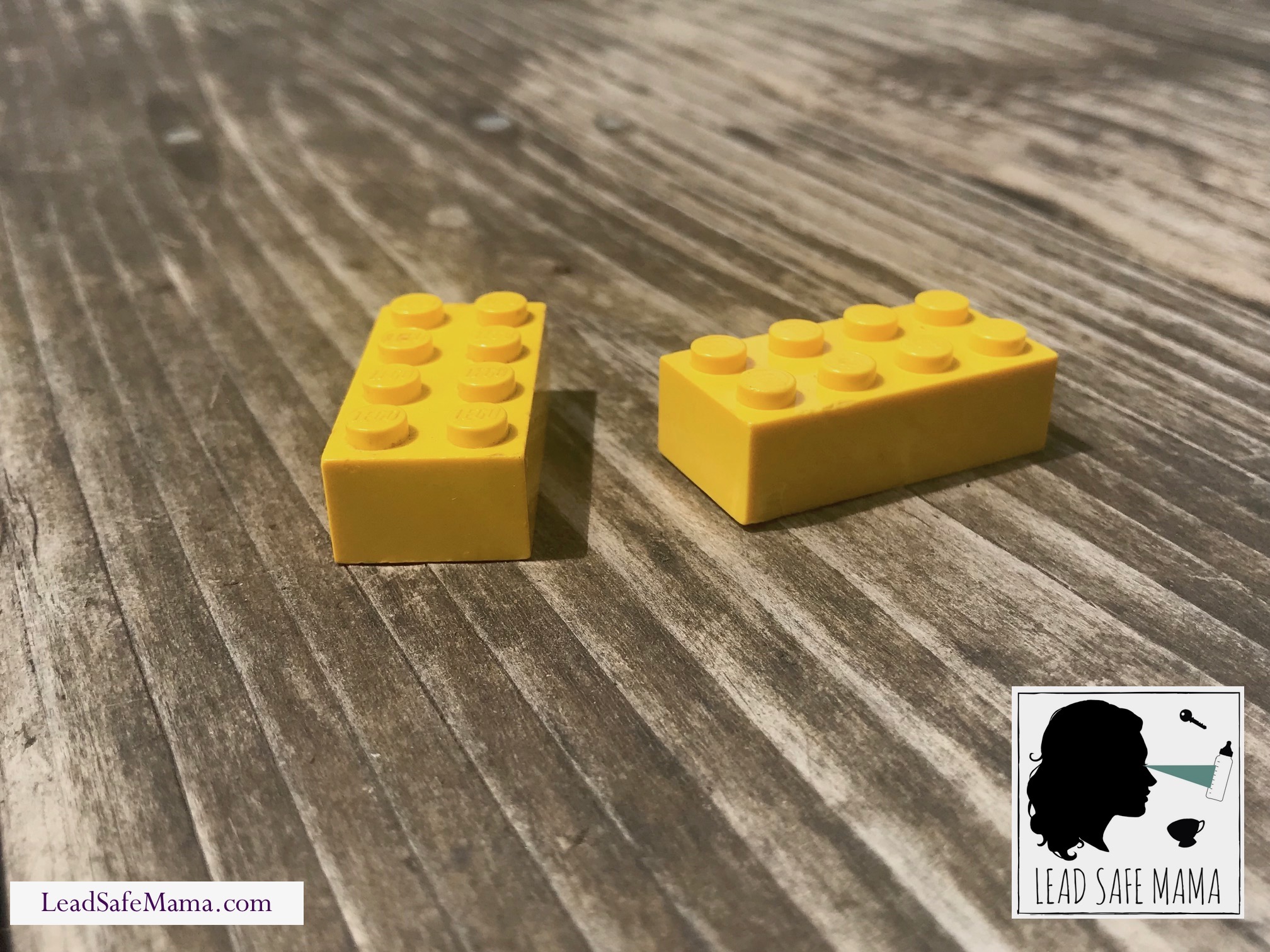
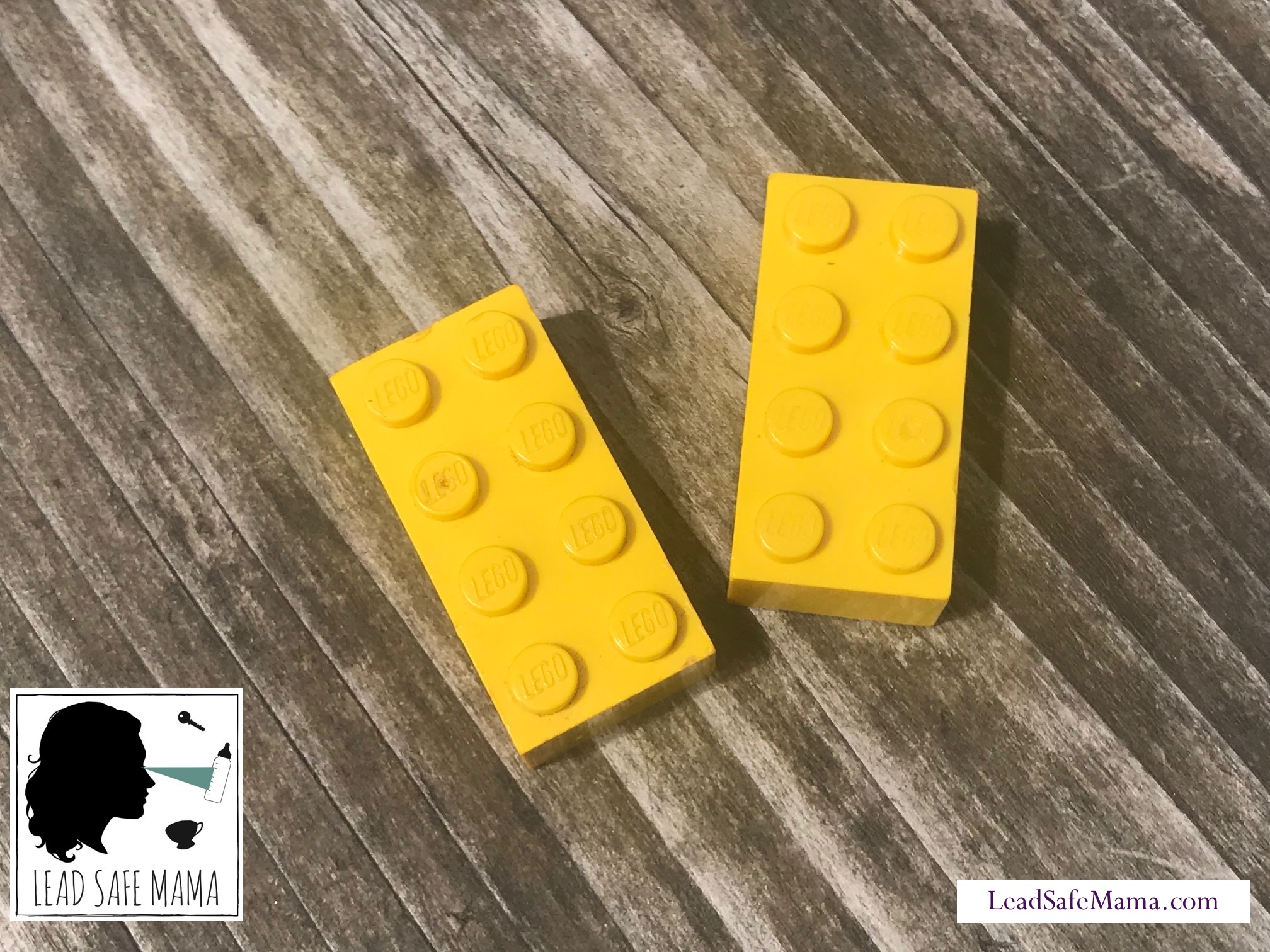
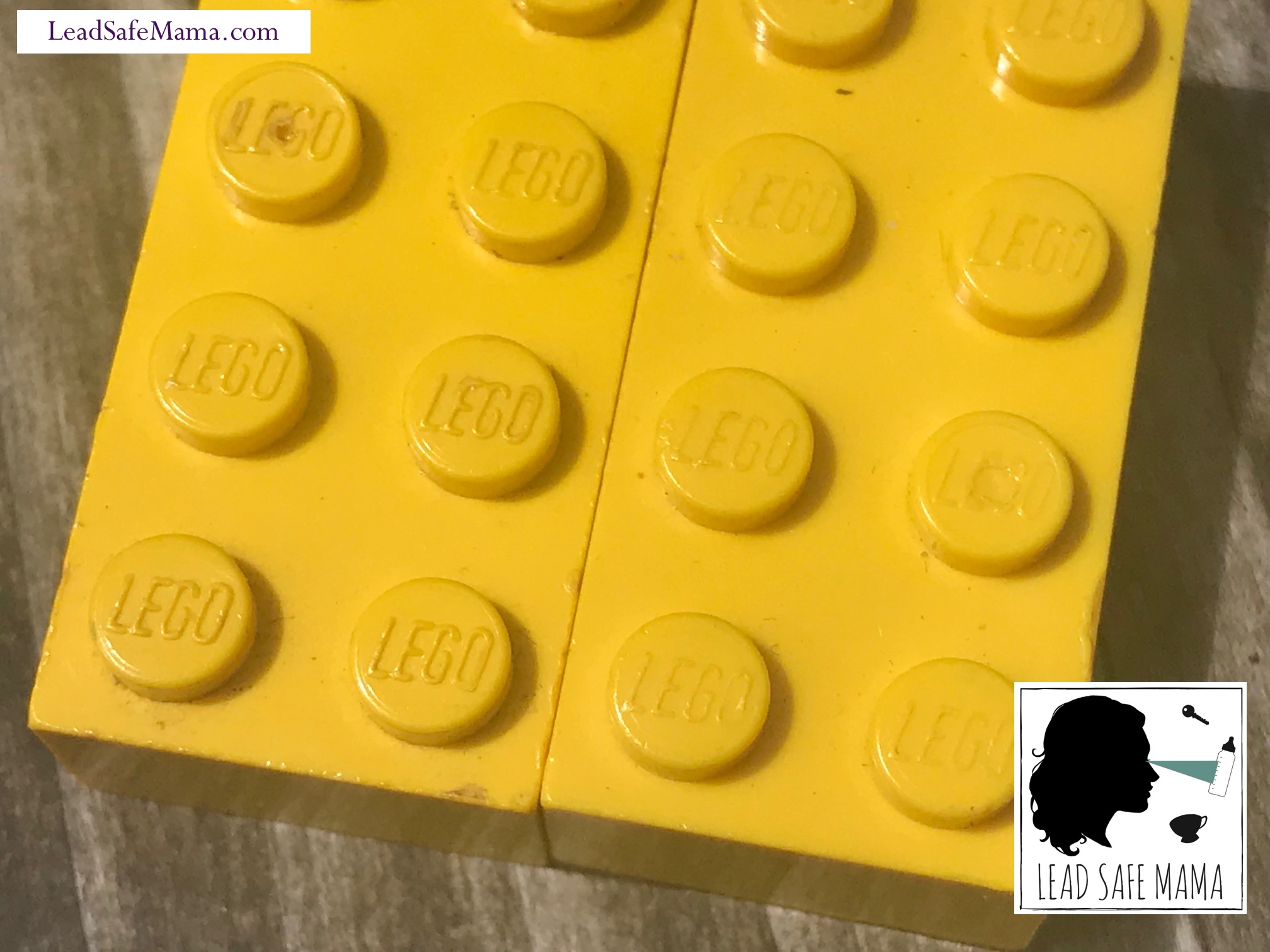
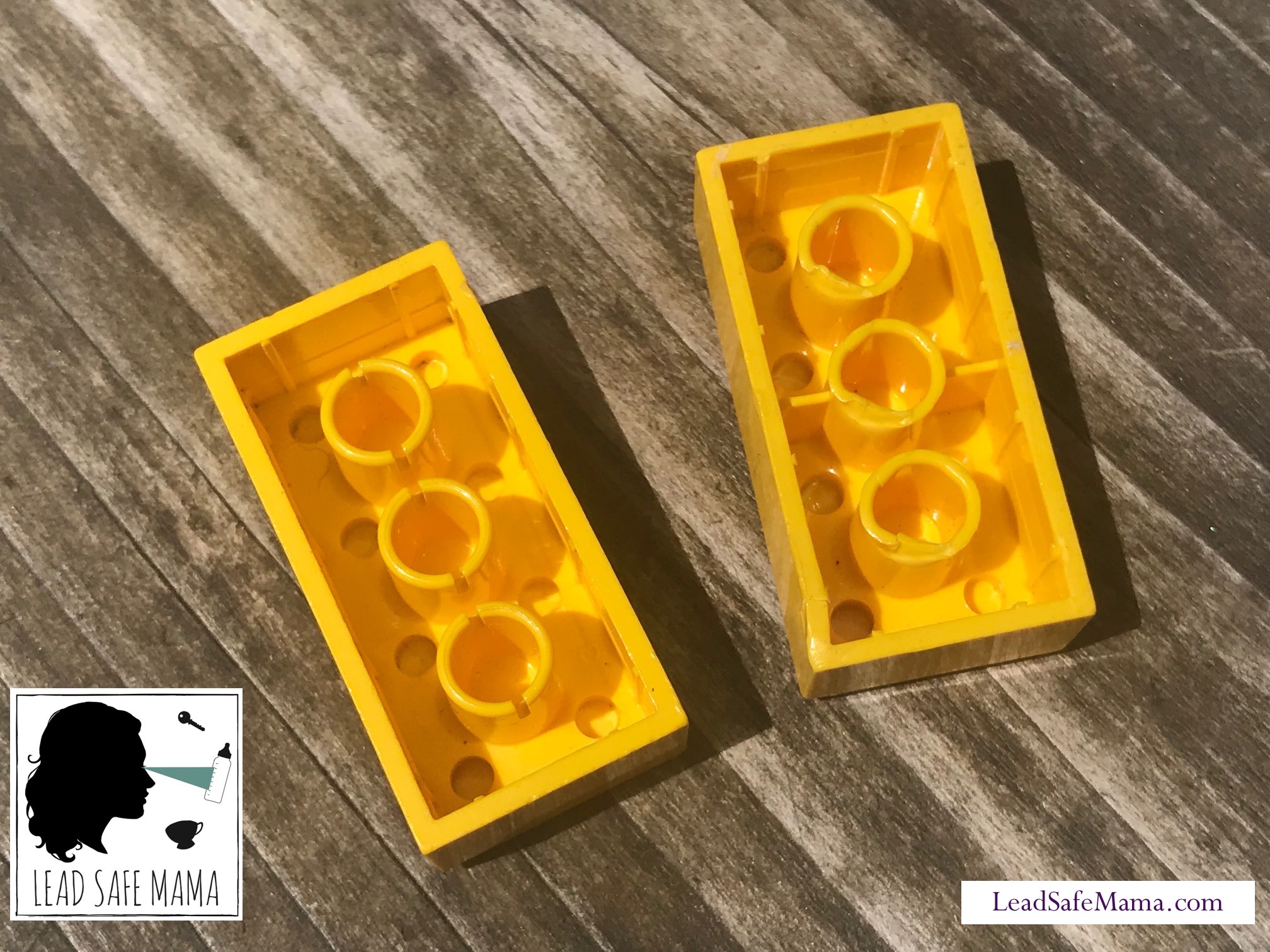
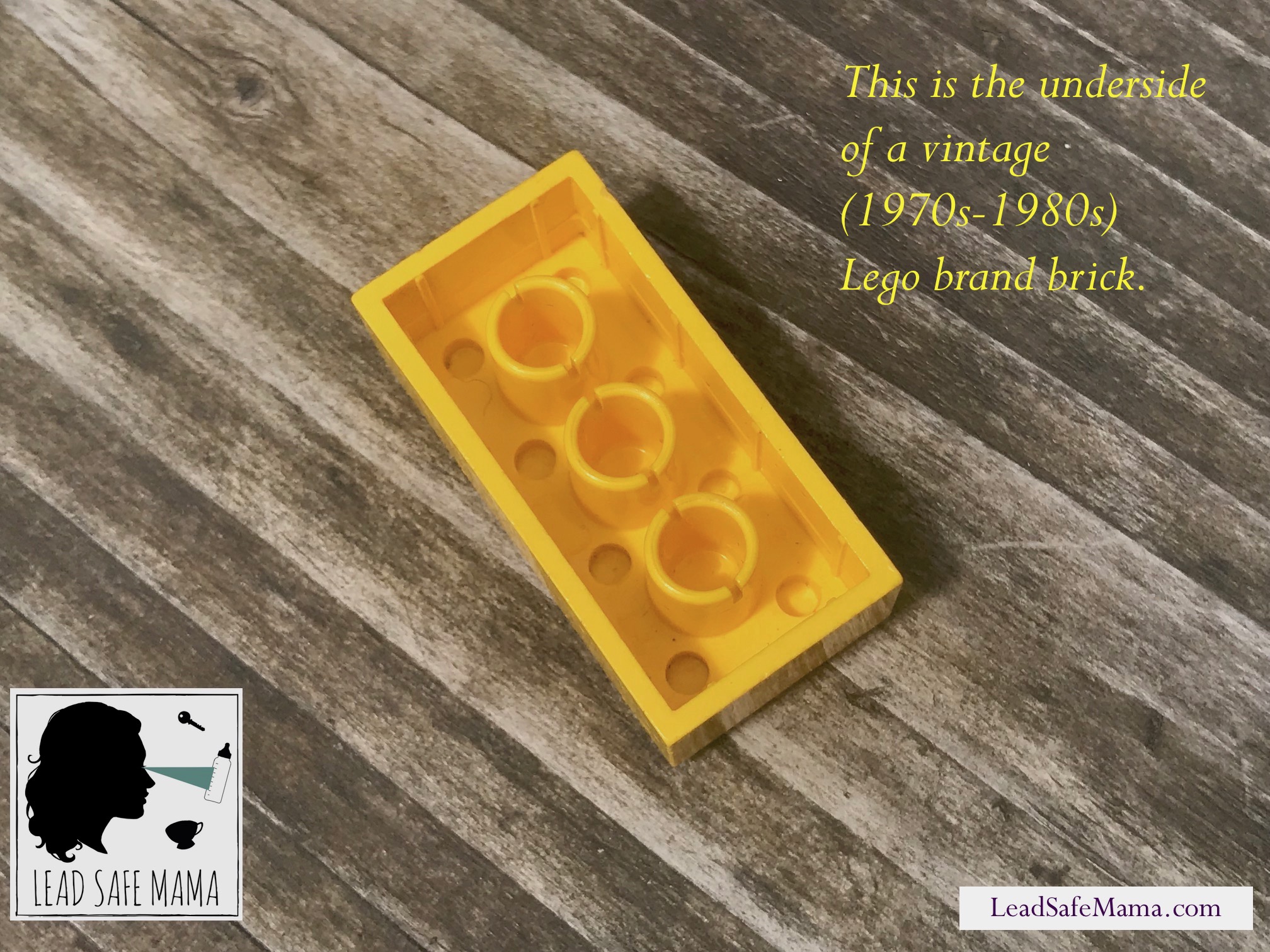
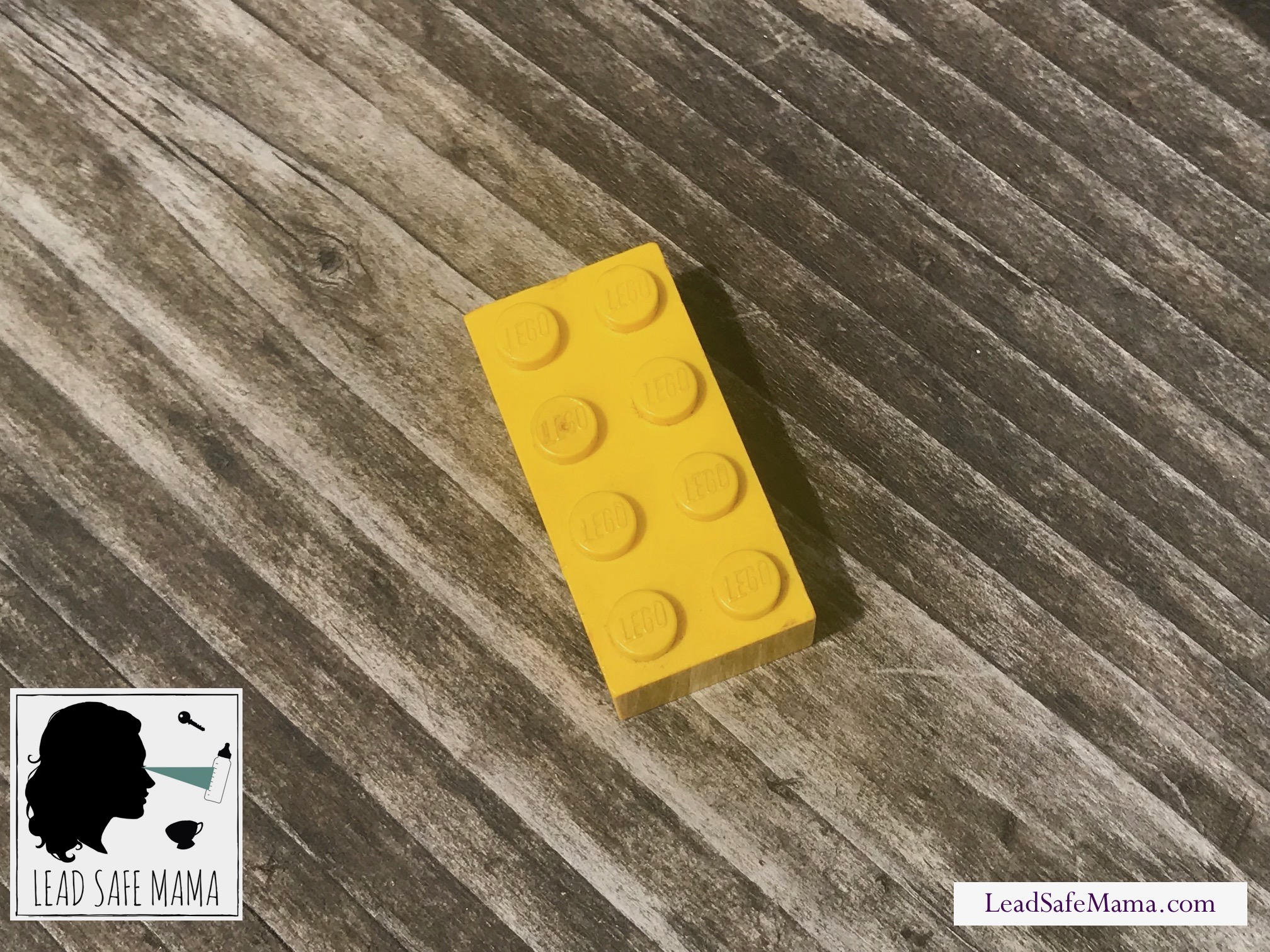

How are consumers advised to dispose of these items, such as Legos and Tupperware that contain Cadmium, Arsenic and other ingredients?
Here’s my post about that, Peggy. It’s an imperfect answer at best. I would consider trying to exchange them with the manufacturer – so they become more aware of customer dissatisfaction over these issues! https://tamararubin.com/2013/11/what-should-i-do-with-my-lead-contaminated-dishes-to-toss-or-not-to-toss/
Tamara
Oh dear Lord! We have thousands of Lego bricks.
Hi Sheryl!
Set aside the reds and yellows and then go looking through them at the back to see which picture they match… it should be fairly quick business – even with thousands of them… We probably have 4 or 5 thousand too (I have no idea!)
Tamara
So you’re saying that white, black and blue are less likely to have toxins? Does that change with year of mfr?
Have a zillion that I’ve purchased at garage sales, etc. Got them out to check and realize they are Duplos. Do you have any information on them?
Duplo are the preschool product made by the LEGO Group. I don’t know for sure but I would assume that the same materials would have been used to produce the “vintage” Duplo as the smaller bricks and would assume that the yellow and red should be treated with the same caution if they are suspected to be from a similar era.
We have a large collection from my husband’s childhood (we think earliest from 1987) mixed in with our kids’ newer LEGO. Can you tell me if this is only concerning the bricks? Not minifigures (whose heads and body parts were all yellow) as well? Any other types of LEGO piece besides the standard bricks? Thank you for all of this info.
Our Legos were bought in the ’90’s so what is your take on these? I was going to let my great nephew enjoy these but I am concerned that they are safe.
Do you think LEGO is testing the old bricks and removing the unsafe ones before passing them on?
Is this a sneaky “recall” method?
https://www.goodnewsnetwork.org/lego-gives-free-shipping-to-donate-unused-bricks-to-kids-in-need/
Hi Linda!
Yeah – I saw that. And NO I don’t think they are testing! They are just likely passing contaminated bricks on to new kids. I need to write a post about that! It’s on my list!
Tamara.
What about Duplos? Also, how can you tell the difference between old and new Duplos? I have some old ones mixed with new ones. The only difference I see is that some say Lego and some older versions say Duplo in the holes.
Thanks for this information. I kept my son’s Lego bricks from the mid 1989’s when he outgrew them and let my students play with them during recess on bad weather indoor days. Now I have a 2 year old grandchild for whom I saved them. Have you ever tried sending the old red, yellow and white bricks back to the company and requested replacements?
I personally have not tried this – sorry! I think it is a good idea though. If enough of us do it perhaps they will take a stand in this area (or at least make a public statement.)
I am also wondering about Duplos. I found your site because I’m sitting here with my two-year-old grandson playing with Duplos and I noticed that the train connector is different on two of them then on the rest. which got me wondering why they were different- come to find out the two are from the ones that I gave him from when my kids were little. (1984-1995) And the big noticeable difference is on the underside do you have any information on Duplos? please and thank you so much for your research and help!
Ok I too have thousands of LEGOs. The vast majority would be 1992 and earlier- and by earlier I mean back to my own brothers who were born in 1963 and 1965.
How can I tell old from older, rather than old from new?
I need more info when you can get it on what amt is potentially leached and whether it can enter the body thru the skin.
Hello,
Thank you for this highly informative post. I am wondering if you think Lego Duplos from the late 90s/early 2000s would be considered safe as far as cadmium levels?
They seem to be Lead and Cadmium free – but I have found what might be considered to be unsafe levels of Antimony in some of the Yellow and Brown ones from that time. It seems to be an intermittent issue – and Antimony does not have regulatory standards for children’s toys. To be on the safe side, if you have a child who puts them in their mouth you might want to get rid of the yellow and brown ones OR set them aside until your child is no longer putting things in their mouth.
Thank you for commenting Alison.
Tamara
Any idea about 1990s legos?
Hi there really great work! Just a quick note to point out a typo – For a second I thought TLC was as going to do a series on toxic toys. See below:
“ We invite TLC to take their proactive stance further at this time – especially in light of Dr. Turner’s 2018 findings on leachability of Cadmium found in their vintage Lego® bricks.”
So I keep seeing bigger concerns around kids putting them in their mouth. My son has been playing with my husband’s vintage legos for years. He doesn’t put them in his mouth. He is 9 now. Should I still get rid of them so he isn’t handling them at all? This is so heartbreaking but I want my son to be safe. My husband is furious with me about this.
I would take some time to research the impacts of Cadmium and weigh that against your family history of cancer (to help you make a decision).
Hello! Do you know how to tell which duplos are new vs. old? Thank you!
It’s really hard to tell unfortunately. I haven’t inquired with the company but you could do that – or check in with some collector forums online. I think the colors are slightly different depending on the age.
T
Hi Tamara thank you for all your work and time!!! It is very appreciated. So from what I read legos from 2010 should be fine right? My son was gifted a Lego set last year but the legos have a mix of years 2010 and 2012 which I thought was odd.
l did some research, but difficult, LEGO Company is ignoring and not helping at all. We should call for a LEGO boycott untill they help, there is now enough quality alternatives for bricks.
LEGO claimes they did not use cadmium after 1981, but how to find out which bricks that are?
https://www.1000steine.de/de/gemeinschaft/forum/img/1243-1672603175.png helps a little bit, at least some hints.
Could you test black bricks pre 1981, some claim they have high cadmium levels, and white, some also say they contain cadmium.
Should also be possible to distinguish them but slight color differences if one has a reference. LEGO could help a lot just giving information on their webpage, but they are not interested in childrens health, just in making profit!